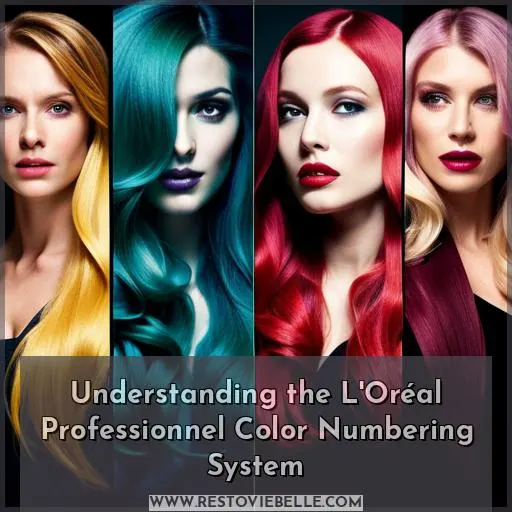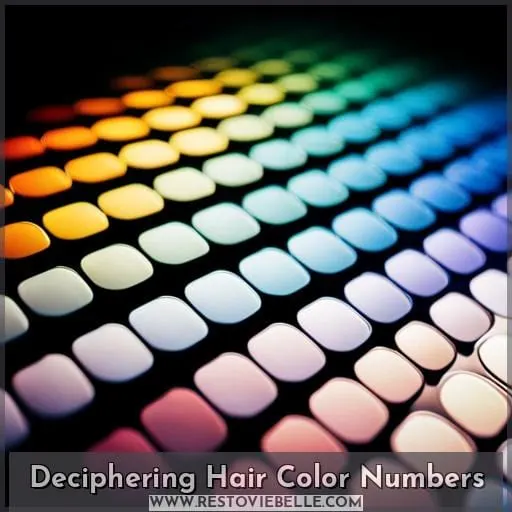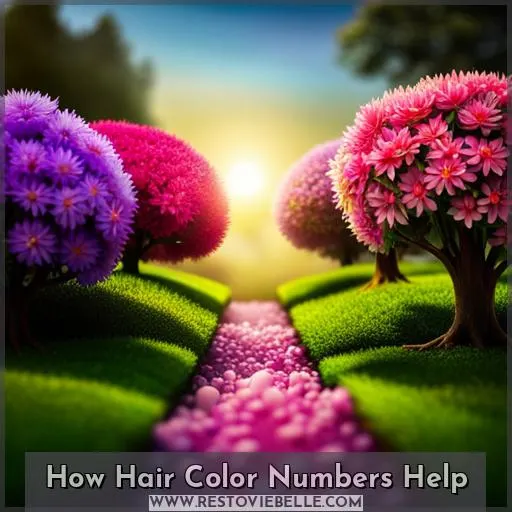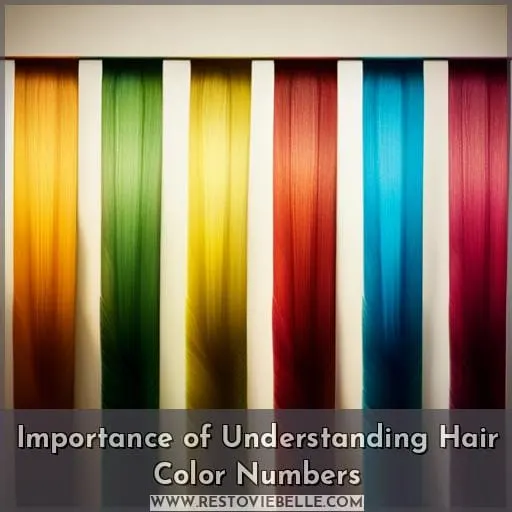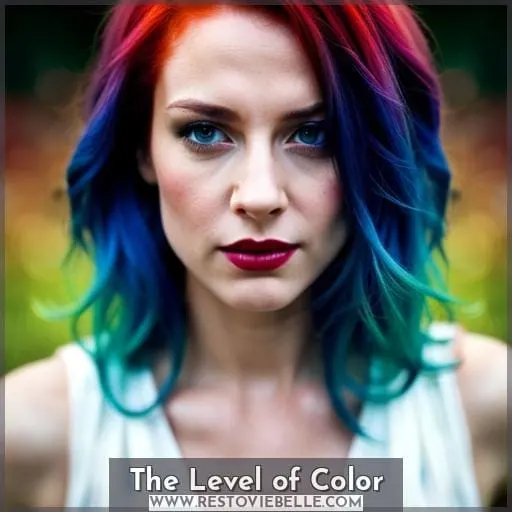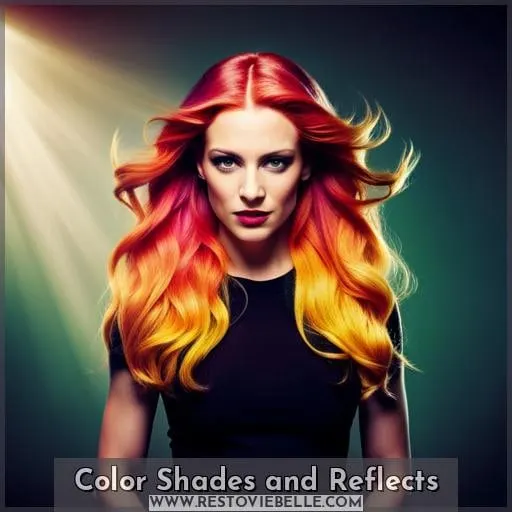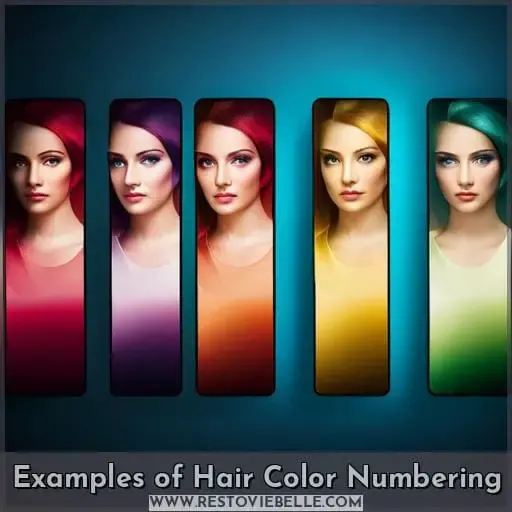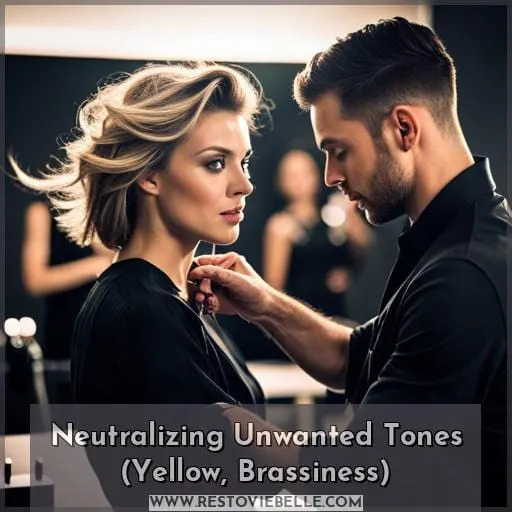This site is supported by our readers. We may earn a commission, at no cost to you, if you purchase through links.
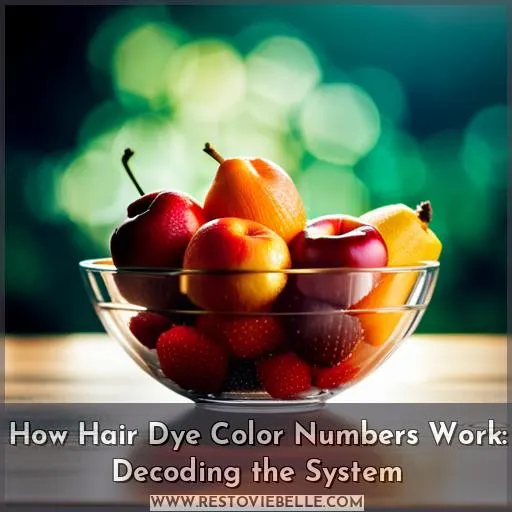 Are you curious about how hair dye color numbers work? If so, you are not alone—many people find the system of assigning numbers to hair colors a bit confusing. By breaking down the components of color depth and base, tone and reflection, letters in hair color numbers, and neutral colors – it is possible to decipher these codes.
Are you curious about how hair dye color numbers work? If so, you are not alone—many people find the system of assigning numbers to hair colors a bit confusing. By breaking down the components of color depth and base, tone and reflection, letters in hair color numbers, and neutral colors – it is possible to decipher these codes.
Understanding this code can help ensure that your desired shade is achieved when coloring your own or someone else’s locks.
Table Of Contents
- Key Takeaways
- Understanding the L’Oréal Professionnel Color Numbering System
- Deciphering Hair Color Numbers
- How Hair Color Numbers Help
- Importance of Understanding Hair Color Numbers
- The Level of Color
- Color Shades and Reflects
- Examples of Hair Color Numbering
- Neutralizing Unwanted Tones (Yellow, Brassiness)
- Conclusion
Key Takeaways
- Hair dye color numbers consist of 4-digit codes indicating natural hair depth and primary and secondary tones or reflections.
- Lower numbers indicate darker shades, while higher numbers mean lighter ones in the level system.
- Neutral colors have the code 0N and represent equal amounts of yellow, blue, and red.
- Factors like undercoat pigment distribution and complementary shades affect hair color results.
Understanding the L’Oréal Professionnel Color Numbering System
By deciphering the L’Oréal Professionnel Color Numbering System, you can mix up the perfect hue for your look and neutralize any unwanted tones. The system consists of 4-figure numbers that indicate a level (1-10) of natural hair depth followed by primary and secondary tones or reflections.
Examples include red, gold, blue ash or letters like A for ash or G for gold to name tones. Neutral colors have equal amounts of yellow, blue, and red with 0 being their number along with an N letter after it.
To get desired results, factors such as undercoat pigment distribution must be taken into account while complementary shades help counteract warmth in tone; opposite colors also neutralize each other (e.
Professional colorists at L’Oréal salons analyze the natural base color based on skin tone & eye color before creating a personalized shade which is enhanced & illuminated when used right! Virtual try-on tools are available to provide inspiration if needed, plus professional guidance helps clients understand how hair dye numbers work, ensuring better outcomes every time!
Deciphering Hair Color Numbers
When deciphering hair color numbers, it’s important to understand the level system of 10 natural hair depths from 1-10. The base color is represented by the first number on the chart, and lower numbers mean darker shades, while higher numbers mean lighter ones.
Some brands also use letters such as A for ash or G for gold to denote tones in their formulas, with a neutral tone having equal amounts of yellow, blue, and red, which are denoted by 0N.
Color Depth and Base Color
Unlock your hair’s ultimate potential by utilizing the level system of 10 numbers, which indicate natural hair depth. The scale ranges from 1 (darkest) to 10 (lightest). Hair dye color numbers work with this scale and base color to create a wide variety of shades and variations based on individual needs.
Color selection includes understanding undertones, mixing dyes for perfect harmony, and selecting complementary colors that neutralize unwanted warmth or brassiness.
- Variations in Levels
- Shade Selection Based on Tone & Undertone
- Balance Color Harmony Across Dye Mixing
- Neutralizing Unwanted Undertones & Warmth
Your ideal shade is achievable! Harness the power of accurate color numbering systems and find a personalized look that emphasizes features while illuminating beauty.
Color Tone and Reflection
Grasp the nuances of hair dye colors with a deeper understanding of their tones and reflections. Hair color numbers are used to determine intensity, shade variations, undertones, and reflection effects.
The number before the slash indicates natural hair depth on a scale from 1-10 (darker shades = lower numbers). A letter after the slash signifies the primary tone, such as A for ash or G for gold. Additional digits represent secondary tones, which are less powerful in sunlight.
To neutralize unwanted warmth, choose complementary or opposite colors like cool ones that counterbalance warm tones.
Letters in Hair Color Numbers
Discover how letters in hair color numbers help you create personalized looks and neutralize unwanted undertones. Hair dyes use letters to indicate tones or shades, like A for ash or G for gold. These letters represent the primary tone with a secondary reflection following it.
Neutral colors have equal amounts of yellow, blue, and red; these are labeled 0N on the chart.
Adding complementary tones can also neutralize underlying undertones so that your hair will be vibrant and beautiful each time you step out of the salon chair! With knowledge about what each letter stands for on your box of dye, you can confidently create gorgeous personalized looks without worry!
Neutral Colors
Experience how neutral colors balance out warm tones with numbers like 0 and the letter N.
Neutral hair shades are achieved by combining equal amounts of yellow, blue, and red on the color wheel.
Professional hair coloring services may use a Neutral tone number (0) to achieve neutrality in your chosen shade.
Coloring products often utilize secondary tones or reflections after primary ones, which can help counteract unwanted warmth from undertones.
Hair dye color numbers allow for better control over final results while neutralizing unwanted warmth when used correctly – creating that perfect hue you’ve been dreaming of!
With expert guidance from a professional hairdresser or colorist, achieving neutrality within your desired hair color is possible without compromising its vibrancy and shine!
How Hair Color Numbers Help
Are you searching for a particular shade of hair color? Hair dye brands utilize numbers to assist in formulating the precise colors that clients desire.
Achieving a Specific Shade
By understanding the nuances of the hair color numbering system, you can achieve a specific shade that best suits your desired look. Choosing formulas and custom blends to ensure precise color accuracy is key. To find tonal balance, consider pigment control and refer to hair color charts for base color options and complementary tone choices.
Unwanted tones can also be countered with special mix colors or opposite colors to neutralize undertones.
Formulating Hair Color
Unlock the secret to stunning color with help from hair color numbers! Hair coloring can be daunting, but knowing how to read and interpret hair dye boxes can make it easier.
It all starts with understanding what each number on the box means. The level system (1-10) indicates the natural depth of shade. The base tone is indicated by the first number after the slash. A lower number means darker shades, while a higher number means lighter hues.
Adding additional digits will show added tones or reflect in the formula. A zero denotes a neutral tone. The proportions between bleach and developer also matter when formulating a desired hue. Using too much will lighten past your goal, while using too little won’t deliver enough pigment intensity.
For the best results, it’s recommended to seek expert advice at salons.
Neutralizing Unwanted Tones
You can neutralize unwanted warm tones by adding complementary reflections to your hair color formula. Tone correction and color balancing are essential for achieving the desired results.
Adding an ash tone, iridescent tone, golden tone, or copper tone can help neutralize any underlying undertones that might be present in your hair.
For a completely neutral look, try using a 0N. This shade represents equal parts of yellow, blue, and red pigments in its formulation. It will give you the perfect balance of coolness without being too stark or brightening up overly dark shades too much.
With careful selection of complimentary colors, it’s easy to achieve subtle adjustments for any shade with professional-level results!
Importance of Understanding Hair Color Numbers
Gaining a better understanding of hair color numbers can help you achieve the desired results when coloring your hair. By learning more about how different brands use various tones and shades to create unique hues, you’ll be able to make informed choices that will give you beautiful, vibrant locks.
Better Color Results
Discover how understanding hair color numbers can ensure better results, with personalized shades to emphasize and illuminate your features. Colorists analyze natural base colors for a bespoke service tailored to skin tone, eye color, and desired shade.
Neutralize unwanted warmth by adding reflects or tones such as blue ash or gold. Professional guidance helps replicate the perfect hair color; consider using a virtual try-on tool for inspiration!
Hair dye box numbers are based on an International Color Chart (ICC), ensuring accurate formulation of colors while preventing subjective misunderstandings between clients and stylists alike.
Achieve beautiful results with neutralization of undertones thanks to complementary tones that cancel each other out – allowing you to get creative without any risks!
Learning More About Hair Dye
Gain a comprehensive understanding of hair dyes and unleash your creative potential for personalized color results. Hair dye techniques, such as color mixing, can help you create unique shades to match current trends or maintain the perfect hue.
When choosing the right shade, it’s important to consider factors like undercoat, pigment distribution, and preferred tone.
Explore all available options—from permanent and semi-permanent dyes to toners that refresh fading colors. With so many possibilities, there’s something for everyone! To ensure long-lasting results, look into proper maintenance routines, including regular trims and deep conditioning treatments tailored specifically for colored hair types.
The Level of Color
Understanding the level of color in hair dye numbers is key to achieving your desired look. When it comes to coloring your hair, you need to know what levels and colors are available so that you can make an informed decision.
The level system has 10 numbers indicating the natural depth of a person’s hair pigment from 1-10. Lower numbers represent darker shades, while higher numbers signify lighter tones.
Additionally, there are reflectives and base colors represented by two or three digits after symbols like.
Then there’s shade intensity – some brands use letters like A for ash or G for gold alongside additional number sequences after slashes (/). These sequences represent the primary tone followed by the secondary reflection in sunlight.
A single digit without a slash stands for a neutral color, while 0/N indicates a natural tone with slight warmth.
Understanding all these factors helps one get closer to their ideal shade. It is important to take into account undercoat pigmentation distribution along with other influencing elements such as skin tone before making a selection!
Color Shades and Reflects
Understanding hair color numbers is key to achieving the desired result when dyeing your hair. Color shades and reflects are two important aspects that can be determined by looking at a four-figure number on the box of hair dye, which takes into account both natural depth levels as well as primary and secondary tones.
Color Shade
Unlock the mystery of hair dye color numbers and add subtle shades to your look with a personalized blend. To make sure you get the perfect shade, consider factors like skin tone, eye color, desired effect, and natural base depth before choosing from a range of trendy or classic colors.
For professional results at home, use correct techniques such as coloring in sections for even coverage and avoiding overlapping old hair dye when applying new product. After application is complete, maintain vibrancy by using sulfate-free shampoos that are gentle on colored tresses while providing nourishment for healthy locks.
If you’re seeking correction or neutralizing unwanted tones, use opposite colors to counteract brassiness or warm hues by adding cool reflections into your hue mix—conveniently achievable through proper identification of pigment numbers!
Color Reflect
Discover how color reflects can add depth and dimension to your hair by neutralizing unwanted undertones. Reflects are subtle tonal hints that show up in sunlight, adding vibrancy and illuminating the shade.
Examples of Hair Color Numbering
Get an up-close look at how hair color numbering works with examples like Garnier Olia Dark Garnet Red, Ion Permanent Creme Hair Color 3RV Burgundy Brown, and L’Oreal Paris Preference Hair Color 6AB Auburn Brown.
The first number in the four-figure sequence indicates the level of natural depth on a scale from 1 to 10.
Secondary tones, such as red or gold, may then follow this primary tone indicated by digits after a slash sign (e.
Combinations can be used for desired effects. Adding.2 or.1 reflects can neutralize unwanted warm tones. Opposite colors like blue reduce brassiness. Complementary tones like cools neutralize warm undertones.
To get personalized results that suit your skin tone and eye color, it’s best to consult professional experts who can analyze your natural base color accurately and choose the right shade for you.
When choosing shades yourself, always consider factors influencing the final result, including undercoat pigment distribution, etc.
Neutralizing Unwanted Tones (Yellow, Brassiness)
Transform your look by neutralizing unwanted tones like yellow and brassiness with the right hair color numbers. Hair dye colors are often labeled using a 4-figure system based on the International Color Chart (ICC).
The first number indicates the lightness or darkness of a shade, while additional digits represent added tones such as red, gold, blue ash, etc.
To neutralize yellow tones and brassiness in particular, you can use complementary shades to counterbalance underlying undertones.
For DIY solutions at home, you can also try toning techniques. Adding.2 or.1 reflects to combat warmth is popular among those looking for quick fixes without making drastic changes to their overall color scheme or base hue.
Professional hairdressers typically analyze your natural base color before suggesting personalized shades that help enhance features while still maintaining an even finish across all strands of hair.
So don’t wait any longer – get creative with different levels and reflections today!
Conclusion
With all the different hair dye options out there, understanding the hair color numbering system can help you achieve the exact shade you desire. By knowing the base color level and the tone and reflection of the dye, you can customize the color to fit your individual needs.
With the help of L’Oréal Professionnel colorists, you can even get a personalized shade to emphasize your features. Hair color numbers provide a universal reference for all hairdressers to ensure better color results and prevent misunderstandings.
To truly unlock the power of hair color numbers, it’s essential to understand how they work and the factors that influence the final color. By doing so, you can neutralize unwanted undertones and get the perfect hair color you’ve been dreaming of.
